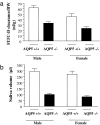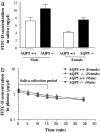Interaction between transcellular and paracellular water transport pathways through Aquaporin 5 and the tight junction complex
- PMID: 17360692
- PMCID: PMC1802728
- DOI: 10.1073/pnas.0608384104
Interaction between transcellular and paracellular water transport pathways through Aquaporin 5 and the tight junction complex
Abstract
To investigate potential physiological interactions between the transcellular and paracellular pathways of water transport, we asked whether targeted deletion of Aquaporin 5 (AQP5), the major transcellular water transporter in salivary acinar cells, affected paracellular transport of 4-kDa FITC-labeled dextran (FITC-D), which is transported through the paracellular but not the transcellular route. After i.v. injection of FITC-D into either AQP5 wild-type or AQP5-/- mice and saliva collection for fixed time intervals, we show that the relative amount of FITC-D transported in the saliva of AQP5-/- mice is half that in matched AQP5+/+ mice, indicating a 2-fold decrease in permeability of the paracellular barrier in mice lacking AQP5. We also found a significant difference in the proportion of transcellular vs. paracellular transport between male and female mice. Freeze-fracture electron microscopy revealed an increase in the number of tight junction strands of both AQP5+/+ and AQP5-/- male mice after pilocarpine stimulation but no change in strand number in female mice. Average acinar cell volume was increased by approximately 1.4-fold in glands from AQP5-/- mice, suggesting an alteration in the volume-sensing machinery of the cell. Western blots revealed that expression of Claudin-7, Claudin-3, and Occludin, critical proteins that regulate the permeability of the tight junction barrier, were significantly decreased in AQP5-/- compared with AQP5+/+ salivary glands. These findings reveal the existence of a gender-influenced molecular mechanism involving AQP5 that allows transcellular and paracellular routes of water transport to act in conjunction.
Conflict of interest statement
The authors declare no conflict of interest.
Figures






Similar articles
-
Salivary acinar cells from aquaporin 5-deficient mice have decreased membrane water permeability and altered cell volume regulation.J Biol Chem. 2001 Jun 29;276(26):23413-20. doi: 10.1074/jbc.M008760200. Epub 2001 Apr 4. J Biol Chem. 2001. PMID: 11290736
-
Water channels and barriers formed by claudins.Ann N Y Acad Sci. 2017 Jun;1397(1):100-109. doi: 10.1111/nyas.13383. Ann N Y Acad Sci. 2017. PMID: 28636801 Review.
-
Claudin-18 Loss Alters Transcellular Chloride Flux but not Tight Junction Ion Selectivity in Gastric Epithelial Cells.Cell Mol Gastroenterol Hepatol. 2021;11(3):783-801. doi: 10.1016/j.jcmgh.2020.10.005. Epub 2020 Oct 16. Cell Mol Gastroenterol Hepatol. 2021. PMID: 33069918 Free PMC article.
-
The structure of tight junctions in mouse submandibular gland.Anat Rec (Hoboken). 2010 Jan;293(1):141-9. doi: 10.1002/ar.21029. Anat Rec (Hoboken). 2010. PMID: 19899114
-
[Claudins as tight junction proteins: the molecular element of paracellular transport].Ross Fiziol Zh Im I M Sechenova. 2013 Feb;99(2):175-95. Ross Fiziol Zh Im I M Sechenova. 2013. PMID: 23650732 Review. Russian.
Cited by
-
Implantable three-dimensional salivary spheroid assemblies demonstrate fluid and protein secretory responses to neurotransmitters.Tissue Eng Part A. 2013 Jul;19(13-14):1610-20. doi: 10.1089/ten.TEA.2012.0301. Epub 2013 May 10. Tissue Eng Part A. 2013. PMID: 23442148 Free PMC article.
-
Cell junctions and oral health.EXCLI J. 2019 Jun 7;18:317-330. doi: 10.17179/excli2019-1370. eCollection 2019. EXCLI J. 2019. PMID: 31338005 Free PMC article. Review.
-
Exosomally Targeting microRNA23a Ameliorates Microvascular Endothelial Barrier Dysfunction Following Rickettsial Infection.Front Immunol. 2022 Jun 23;13:904679. doi: 10.3389/fimmu.2022.904679. eCollection 2022. Front Immunol. 2022. PMID: 35812423 Free PMC article.
-
[Role and mechanism of muscarinic acetylcholine receptor in the regulation of submandibular gland secretion].Beijing Da Xue Xue Bao Yi Xue Ban. 2019 Jun 18;51(3):390-396. doi: 10.19723/j.issn.1671-167X.2019.03.003. Beijing Da Xue Xue Bao Yi Xue Ban. 2019. PMID: 31209407 Free PMC article. Chinese.
-
Roles of AQP5/AQP5-G103D in carbamylcholine-induced volume decrease and in reduction of the activation energy for water transport by rat parotid acinar cells.Pflugers Arch. 2012 Oct;464(4):375-89. doi: 10.1007/s00424-012-1141-8. Epub 2012 Aug 19. Pflugers Arch. 2012. PMID: 22903161
References
-
- Zeuthen T. Int Rev Cytol. 2002;215:285–317. - PubMed
-
- Tripathi S, Boulpaep EL. Q J Exp Physiol. 1989;74:385–417. - PubMed
-
- Guyton AC, Hall JE. In: Textbook of Medical Physiology. Hall JE, editor. Philadelphia: Saunders; 2000. pp. 295–312.
-
- Robben JH, Knoers NV, Deen PM. Am J Physiol. 2006;291:F257–F270. - PubMed
Publication types
MeSH terms
Substances
Grants and funding
LinkOut - more resources
Full Text Sources
Other Literature Sources
Molecular Biology Databases

